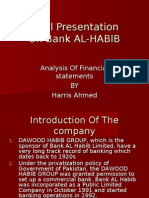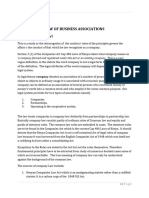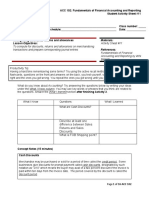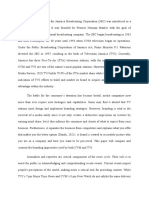0 ratings0% found this document useful (0 votes)
8 viewsAccounts Ratio
Accounts Ratio
Uploaded by
Anushkaa DattaEPS measures the earnings returned on the initial investment amount. It shows how much of a business's profits can be attributed to each share and is considered the most important variable in determining a share's market price. A higher EPS is better for shareholders as it means higher earnings and dividends, increasing the share value. However, EPS does not consider the capital required to generate earnings, so ROCE should also be examined. The PE ratio measures investor confidence in future company performance by how many times the EPS investors are willing to pay. A higher PE ratio indicates more investor confidence while a lower one means shares are underpriced. DPS measures actual dividends received by shareholders while DYR measures dividends as a percentage of share price
Copyright:
© All Rights Reserved
Available Formats
Download as DOCX, PDF, TXT or read online from Scribd
Accounts Ratio
Accounts Ratio
Uploaded by
Anushkaa Datta0 ratings0% found this document useful (0 votes)
8 views3 pagesEPS measures the earnings returned on the initial investment amount. It shows how much of a business's profits can be attributed to each share and is considered the most important variable in determining a share's market price. A higher EPS is better for shareholders as it means higher earnings and dividends, increasing the share value. However, EPS does not consider the capital required to generate earnings, so ROCE should also be examined. The PE ratio measures investor confidence in future company performance by how many times the EPS investors are willing to pay. A higher PE ratio indicates more investor confidence while a lower one means shares are underpriced. DPS measures actual dividends received by shareholders while DYR measures dividends as a percentage of share price
Original Title
Accounts ratio
Copyright
© © All Rights Reserved
Available Formats
DOCX, PDF, TXT or read online from Scribd
Share this document
Did you find this document useful?
Is this content inappropriate?
EPS measures the earnings returned on the initial investment amount. It shows how much of a business's profits can be attributed to each share and is considered the most important variable in determining a share's market price. A higher EPS is better for shareholders as it means higher earnings and dividends, increasing the share value. However, EPS does not consider the capital required to generate earnings, so ROCE should also be examined. The PE ratio measures investor confidence in future company performance by how many times the EPS investors are willing to pay. A higher PE ratio indicates more investor confidence while a lower one means shares are underpriced. DPS measures actual dividends received by shareholders while DYR measures dividends as a percentage of share price
Copyright:
© All Rights Reserved
Available Formats
Download as DOCX, PDF, TXT or read online from Scribd
Download as docx, pdf, or txt
0 ratings0% found this document useful (0 votes)
8 views3 pagesAccounts Ratio
Accounts Ratio
Uploaded by
Anushkaa DattaEPS measures the earnings returned on the initial investment amount. It shows how much of a business's profits can be attributed to each share and is considered the most important variable in determining a share's market price. A higher EPS is better for shareholders as it means higher earnings and dividends, increasing the share value. However, EPS does not consider the capital required to generate earnings, so ROCE should also be examined. The PE ratio measures investor confidence in future company performance by how many times the EPS investors are willing to pay. A higher PE ratio indicates more investor confidence while a lower one means shares are underpriced. DPS measures actual dividends received by shareholders while DYR measures dividends as a percentage of share price
Copyright:
© All Rights Reserved
Available Formats
Download as DOCX, PDF, TXT or read online from Scribd
Download as docx, pdf, or txt
You are on page 1of 3
EPS: measures the earnings returned on the initial investment amount.
Earnings that are left for ordinary shareholders after payment of
interest, tax, and preference dividends. In other words, EPS shows how much of a business’s profits can be attributed to each issued equity
share. It is generally considered to be the single most important variable in determining a share’s market price. It is also a major
component of the PE ratio. It is useful to compare the results of the company over several years, the performance of the company’s equity
shares against another company’s equity shares, and the earnings against a return available from an alternative investment.
The greater the ratio the better it is for shareholders or investors. Higher earnings or profits left for ordinary dividends make shareholders
happy and stimulate higher investment. Also, some of the profit is retained, and the retained earnings or the general reserve increases,
which further increases the value of the shares in the SOFP, again due to higher attraction of investments towards the higher net worth of
the company. Either way, shareholders always benefit from higher EPS. Retaining of the profits also helps in lowering the gearing ratio and
hence lowering of risks of the business.
An important aspect of EPS that’s often ignored is the capital that is required to generate the earnings in the calculation. Two companies
could generate the same EPS figure, but one could do so with less equity(investment) – that company would be more efficient at using its
capital to generate income and, all other things being equal would be a ‘better’ company. Hence ROCE should also be considered to
determine which company could continue to give the highest return in terms of efficiency and thus future performance.
Investors also need to be aware of the earnings manipulation that will affect the quality of the earnings number. There could be practices
of window dressing and income smoothing within a business, which is not safe from an investor's point of view, for trusting the director of
the business. It is important not to rely on any one financial measure, but to use it in conjunction with other measures.
PE ratio: measures the confidence levels of investors about the future performance of the business. It indicates how many multiples of the
EPS; the investor is willing to pay to buy the share. By relating price and earnings per share for a company, one can analyse the market’s
valuation of a company’s shares relative to the wealth the company is creating.
The higher the ratio, the more confident investors are in the company earning increasing profit in the future, and the more the market is
willing to pay for each dollar of annual earnings. The lower the ratio, the less investors have to pay for the share, relative to what they
expect to earn from it. Hence, from a company’s point of view, a high ratio is beneficial due to a higher market price of the share, hence a
higher ability to raise finance. From an investor’s point of view, a high ratio is an assurance of ‘good’ expected return from their investment.
However, it is probably the single most consistent red flag of excessive optimism and over-investment. It also serves regularly, as a marker
of business problems and opportunities. Too high a ratio can be risky for the company as well, as any downfall of the company’s
performance or social influences will drastically decrease the market price of the share, as investors become reluctant to continue with the
high investment in the company.
The reason for calculating the PE ratio is for investors to compare the value of shares, one share with another. If one share has twice the
ratio than that of another share, the latter is probably a less attractive investment. However, comparisons between industries, countries,
and time periods may be dangerous. To have faith in the comparison of the PE ratio, one should compare comparable shares, especially
between companies within the same industry.
DPS: measures the average dividend each shareholder actually gets in return for their investment. It is the amount each shareholder has
(or will) receive for each share they own. It is also used to calculate DYR.
It is an important ratio as most companies avoid dividend cuts unless their financial condition demands it or there has been some other
change in the business or its capital structure. As a result of this, ordinary shareholders or investors prefer high DPS as this is taken to be a
sign that the management is confident that the high dividends can be maintained or improved on. This results in higher DYR but lower DC.
However high DPS due to a reckless dividend policy indicates a risky company, as any small reduction in profits may have an adverse effect
on dividends in the future.
DYR: measures the actual dividend received by the shareholders as a percentage of the market price of the share. The ratio tells investors
how much they are earning on an ordinary share from the dividend alone based on the current market price. Hence the higher the ratio,
the better it is for the shareholders.
A high DYR can be considered to be evidence that a share is under-priced or that the company has fallen on hard times and future
dividends will not be as high as previous ones. Similarly, a low DYR can be considered evidence that the share is overpriced or that the
future dividends might be higher.
Investors may compare this ratio with other competing businesses or forms of investment (e.g., depositing money into interesting-bearing
bank accounts) to aid their decision-making.
DC: measures how many times the ordinary dividends could have been paid out of the available profit. This shows the likelihood that the
company can continue paying the current rate of ordinary dividends.
High DC may reflect the director’s conservative dividend policy as it suggests that much of the profit available to pay dividends is being
reinvested within the business.
Low dividend cover could also indicate a reckless or aggressive dividend policy as it implies that a lower proportion of earnings are being
reinvested in the business. As a result, the company may face difficulty in paying dividends at the same or even at higher rates in the
coming years. Or in another case, there is a decrease in business profits, but the directors want to pay dividends at a consistent rate to
satisfy the shareholder's expectations.
A high figure is good since it indicates that the company is making sufficient profits to sustain the payment of future dividends as this
would imply a larger percentage of earnings are being retained and reinvested in the business. On the other hand, a low cover might
indicate that future dividends are at risk if profitability declines. The companies thus need to strike a balance between the dividend
payment and the profits retained within the business.
Low DC may be beneficial to short-term investments, but high DD often indicates better future long-term returns of the investment.
NWATR: indicates how efficiently the networking assets are being used to generate sales. It gives a glimpse of the liquidity position from
yet another side. The other liquidity measures like the current ratio or the acid test ratio use SOFP figures only, whereas in this ratio, the
ongoing operations of the company are considered including yearly sales revenue from the SP/L. this ratio is considered as a prime
indicator of a company’s ability to expand its operations without taking on additional debt as with the increase in sales, working asset
requirements also rise.
The ratio provides an insight into the likely amount of additional working assets funding required from a given increase in sales. For
instance, if the ratio is 20% this means that the company will require networking assets of 20 cents for every increase of $1 in sales. As the
increase in working assets requirements needs finance so management tries to minimize the level of networking assets in relation to sales.
This ratio is a useful measure of the amount of money that is tied up in funding the day-to-day trading activities of the business as it
includes only those current assets and current liabilities that vary in direct proportion to sales turnover. It is possible to have a stable "
current" or " quick" ratio while this ratio is falling. This would happen if sales were increasing rapidly without a corresponding increase in
networking assets. This low ratio may indicate ' over trading' (excessive sales volume in relation to lower working assets investment in the
business). This may also indicate that the business relies extensively upon credit granted by suppliers or the bank as a substitute for an
adequate margin of operating funds.
The lower ratio is usually preferred as it indicates that more of the working assets have been financed by short-term funds resulting in a
lower amount of net working assets. On the other hand the larger the ratio, the more finance will be needed to fund larger requirements
of networking assets in relation to sales.
IC: gives an idea of how well-equipped the business is to meet its interest payments. It is of particular interest to debenture-holders and
other lender.
Low IC is not considered a good sign as it shows lower operating profit earned. The IC should not be less than 1 as it indicates that the
business is not generating adequate revenue to meet interest expense.
The larger the IC, the better as it provides a safety margin against a fall in profits. It is also useful to ordinary shareholders who know that
dividends are going to be paid if there is sufficient profit left after all finance costs have been paid.
GR: how reliant the business is on external fixed cost capital. Greater than 50% of the ratio is accepted to be a highly geared company.
A high GR ratio indicates the company is in a risky situation, as the company is loaded with fixed finance charges, and the greater the risk
that the operating profit will be insufficient to cover interest payments. Higher interest payments result in lower IC which is also not a good
sign. This in turn causes lenders unwilling to lend. The IC should not be less than 1 as it indicates that the business is not generating
adequate revenue to meet interest expense. Higher interest payments due to higher fixed cost capital account for a large proportion of
profits of the company and investors may be concerned with lower profits available for dividends.
Fixed cost capital often requires the amount borrowed to be paid back over a scheduled period, so there might be significant monthly or
yearly payments, regardless of how well the business is performing. This could cause cash flow problems.
A low gearing ratio is hence accepted to be better, to avoid such problems. A company that is low-geared will have much of its finance in
the form of capital and reserves, which increases the net worth of the company as well as potential dividends for shareholders, stimulating
an attractive investment option. The company is also more likely to easily raise additional finance by asking each shareholder to increase
their investment by a relatively small proportion than by a large proportion.
WCC: measures the time required to purchase inventory, sell the product, and collect the cash. So, it shows the time lag between the flow
of cash out of the business on account of purchases and back into it again as a result of normal trading operations i.e. collection from
customers. A business should not over-invest in working capital. A longer cash cycle ties up a bigger investment in working capital. It is
therefore useful to monitor the length of the cash cycle, and changes in it, to judge whether a business has an excessive working capital
level or perhaps whether working capital is inadequate which may lead to liquidity problems.
A short working capital cycle is preferred as it indicates the business is well managing its working capital and lowers the value of working
capital to be financed from other sources. On the other hand, the longer the working capital cycle the larger will be the funds tied up.
For simplicity, the working capital cycle assumes that the turnover period of accounts receivable and the turnover period of accounts
payable can be treated as completely independent items. In reality, this may not be the case. When customers wait too long to pay, it
impacts a company's cash flow and prevents on-time deliveries to suppliers. Of course, if the customer pays quickly, the company has the
option of paying off the debt faster. This may depend, among other things, on whether he is offered a discount for on-time payments.
You might also like
- Cambridge International As A Level Mathematics Probability and Statistics 2 Worked Solutions Manual With Cambridge Elevate Dean Chalmers Z LibDocument88 pagesCambridge International As A Level Mathematics Probability and Statistics 2 Worked Solutions Manual With Cambridge Elevate Dean Chalmers Z LibAnushkaa Datta100% (2)
- Assignment Questions - Suggested Answers (E3-7, E3-10, E3-11, P3-4, P3-6) E3-7. (Dollars in Millions)Document10 pagesAssignment Questions - Suggested Answers (E3-7, E3-10, E3-11, P3-4, P3-6) E3-7. (Dollars in Millions)Ivy KwokNo ratings yet
- Atchison Village, City of Richmond CA RFP Final-Mini-Historic Structures Report/Preservation PlanDocument9 pagesAtchison Village, City of Richmond CA RFP Final-Mini-Historic Structures Report/Preservation PlanLori100% (1)
- Tax 301-A-Other Percentage Taxes: Taxation E.J. Garcia/J. CoDocument4 pagesTax 301-A-Other Percentage Taxes: Taxation E.J. Garcia/J. Cobeayao50% (2)
- Financial Statement Analysis - ExplainedDocument21 pagesFinancial Statement Analysis - ExplainedShyamasundaraNo ratings yet
- In Other Words, This Ratio Calculates How Much Money Is Made Based On The Investors' Investment in The Company, Not The Company's Investment in Assets or Something ElseDocument4 pagesIn Other Words, This Ratio Calculates How Much Money Is Made Based On The Investors' Investment in The Company, Not The Company's Investment in Assets or Something ElseVibhav.b. rajNo ratings yet
- Financial Ratios Are Mathematical Comparisons of Financial Statement Accounts or Categories. TheseDocument3 pagesFinancial Ratios Are Mathematical Comparisons of Financial Statement Accounts or Categories. TheseEllaine Pearl AlmillaNo ratings yet
- Key Ratios For Picking Good Stocks: 1. Ploughback and ReservesDocument6 pagesKey Ratios For Picking Good Stocks: 1. Ploughback and ReservesAnonymous YkDJkSqNo ratings yet
- 8 Keys Ratios To Look at Before Buying A ShareDocument10 pages8 Keys Ratios To Look at Before Buying A ShareSiva SubrahmanyamNo ratings yet
- Screening Criteria: P/E RatioDocument5 pagesScreening Criteria: P/E RatiovenkatNo ratings yet
- FundamentalDocument11 pagesFundamentalMhsh GalfNo ratings yet
- P/E RatioDocument4 pagesP/E Ratio15vinayNo ratings yet
- C.A IPCC Ratio AnalysisDocument6 pagesC.A IPCC Ratio AnalysisAkash Gupta100% (2)
- Chap 6 (Fix)Document13 pagesChap 6 (Fix)Le TanNo ratings yet
- RatioDocument5 pagesRatiomob1022No ratings yet
- 1.+FRA - Study+Guide - v2.0 17Document3 pages1.+FRA - Study+Guide - v2.0 17Jerlin PreethiNo ratings yet
- 3.1. Problem Statement: Supply DemandDocument29 pages3.1. Problem Statement: Supply DemandAysha LipiNo ratings yet
- Tata Motors.: Liquidity RatiosDocument11 pagesTata Motors.: Liquidity RatiosAamir ShadNo ratings yet
- Ratios ExplainedDocument4 pagesRatios ExplainedSACHIDANAND KANDLOORNo ratings yet
- An Introduction To Fundamental Analysis: Jason O Bryan 19 September 2006Document23 pagesAn Introduction To Fundamental Analysis: Jason O Bryan 19 September 2006Saumil ShahNo ratings yet
- Market RatioDocument11 pagesMarket RatioThảo LêNo ratings yet
- Discounting Cash FlowDocument9 pagesDiscounting Cash FlowBhavinRamaniNo ratings yet
- Financial RatiosDocument6 pagesFinancial RatiosToan BuiNo ratings yet
- Importance of PE Ratio For Investing in Mutual FundsDocument5 pagesImportance of PE Ratio For Investing in Mutual FundsAnonymous So5qPSnNo ratings yet
- Smart Task 1 Vardhan ConsultingDocument10 pagesSmart Task 1 Vardhan Consulting2K19/PS/053 SHIVAMNo ratings yet
- Stock Market TermsDocument20 pagesStock Market TermsAbhijit ModakNo ratings yet
- RATIOS InterpretationsDocument4 pagesRATIOS InterpretationsMas'ud KhanNo ratings yet
- Gross Profit Net Sales - Cost of Goods Sold Net Sales Gross Sales - Sales ReturnsDocument10 pagesGross Profit Net Sales - Cost of Goods Sold Net Sales Gross Sales - Sales ReturnsZeath ElizaldeNo ratings yet
- Specific RatiosDocument26 pagesSpecific RatiosSunil KumarNo ratings yet
- Profitability RatiosDocument8 pagesProfitability Ratiosbiplobsinhamats100% (1)
- 1.+FRA - Study+Guide - v2.0 16Document4 pages1.+FRA - Study+Guide - v2.0 16Jerlin PreethiNo ratings yet
- Profitability INTRODUCTIONDocument22 pagesProfitability INTRODUCTIONDEEPANo ratings yet
- Profitability INTRODUCTIONDocument19 pagesProfitability INTRODUCTIONDEEPANo ratings yet
- Business Accounting RatiosDocument18 pagesBusiness Accounting RatiosAhmed AdelNo ratings yet
- Net Profit Margin:: SignificanceDocument7 pagesNet Profit Margin:: Significanceamisha kbNo ratings yet
- Task 3 - Investment AppraisalDocument12 pagesTask 3 - Investment AppraisalYashmi BhanderiNo ratings yet
- There Are So Many Fundamental Analysis ParametersDocument8 pagesThere Are So Many Fundamental Analysis Parametersanimesh dasNo ratings yet
- Financial RatiosDocument7 pagesFinancial RatiosVikram KainturaNo ratings yet
- 58 Ratio Analysis Techniques PDFDocument8 pages58 Ratio Analysis Techniques PDF9raahuulNo ratings yet
- Return On EquityDocument7 pagesReturn On EquityTumwine Kahweza ProsperNo ratings yet
- Week 2 NotesDocument2 pagesWeek 2 NotesLuke NogueiraNo ratings yet
- Ratio Formula RemarksDocument7 pagesRatio Formula RemarksmgajenNo ratings yet
- Valuation MethodsDocument4 pagesValuation MethodsulandteNo ratings yet
- Financial ManagementDocument8 pagesFinancial ManagementAayush JainNo ratings yet
- Where Do You See This?: What Does Leverage Mean?Document6 pagesWhere Do You See This?: What Does Leverage Mean?abhijeet1828No ratings yet
- Tauheed, Balance Trader PresentationDocument8 pagesTauheed, Balance Trader PresentationMaxingal GamerNo ratings yet
- Interview Questions - Consolidated-1Document51 pagesInterview Questions - Consolidated-1Abhineet NirvanNo ratings yet
- DEFINITION of 'Price-Earnings Ratio - P/E Ratio'Document2 pagesDEFINITION of 'Price-Earnings Ratio - P/E Ratio'peterNo ratings yet
- Question: Is ROA A Better Performance Measurement Than ROE? DiscussDocument6 pagesQuestion: Is ROA A Better Performance Measurement Than ROE? DiscusssureshdassNo ratings yet
- FINANCIAL ANALY-WPS OfficeDocument9 pagesFINANCIAL ANALY-WPS OfficeJoy PlacidoNo ratings yet
- Key Evaluation RatiosDocument16 pagesKey Evaluation RatiosLiya ThomasNo ratings yet
- 2012 '000 2011 '000 Long-Term Liabilities Capital Employed Gearing RatioDocument5 pages2012 '000 2011 '000 Long-Term Liabilities Capital Employed Gearing Ratioolivia66wardNo ratings yet
- MAS Financial RatiosDocument6 pagesMAS Financial RatiosMarian's PreloveNo ratings yet
- FM 3-4Document13 pagesFM 3-4shaik.712239No ratings yet
- Most Important Financial Ratios For InvestorsDocument14 pagesMost Important Financial Ratios For InvestorsBhavin dalalNo ratings yet
- "Portfolio Management": Indian Institute of Planning and Management New DelhiDocument8 pages"Portfolio Management": Indian Institute of Planning and Management New DelhiAjay PawarNo ratings yet
- Sandhani Life UF GrowthDocument12 pagesSandhani Life UF Growthnahid250No ratings yet
- Thumb For Acceptable Values Are: Current Ratio (2:1), Quick Ratio (1:1)Document4 pagesThumb For Acceptable Values Are: Current Ratio (2:1), Quick Ratio (1:1)Sehrish SiddiquiNo ratings yet
- Final Presentation On Bank Al-HabibDocument25 pagesFinal Presentation On Bank Al-Habibimran50No ratings yet
- Financial Ratios SummaryDocument8 pagesFinancial Ratios SummaryHany BadrNo ratings yet
- Pegasus Ratio Analysis1 (1) Final-1Document38 pagesPegasus Ratio Analysis1 (1) Final-1Bella BellNo ratings yet
- DIVIDEND INVESTING: Maximizing Returns while Minimizing Risk through Selective Stock Selection and Diversification (2023 Guide for Beginners)From EverandDIVIDEND INVESTING: Maximizing Returns while Minimizing Risk through Selective Stock Selection and Diversification (2023 Guide for Beginners)No ratings yet
- Dividend Investing for Beginners & DummiesFrom EverandDividend Investing for Beginners & DummiesRating: 5 out of 5 stars5/5 (2)
- Ias 7Document3 pagesIas 7Anushkaa DattaNo ratings yet
- Acc Theory AnswersDocument22 pagesAcc Theory AnswersAnushkaa DattaNo ratings yet
- p1 Circular Measure NotesDocument13 pagesp1 Circular Measure NotesAnushkaa DattaNo ratings yet
- RevenueDocument14 pagesRevenueAnushkaa DattaNo ratings yet
- Screenshot 2023-10-10 at 6.20.33 PMDocument13 pagesScreenshot 2023-10-10 at 6.20.33 PMAnushkaa DattaNo ratings yet
- Costs of Production (Unit III)Document35 pagesCosts of Production (Unit III)Anushkaa DattaNo ratings yet
- BA (H) EcoSem4 Macroeconomics-II Module 4Document46 pagesBA (H) EcoSem4 Macroeconomics-II Module 4Anushkaa DattaNo ratings yet
- TAX - Individual TaxationDocument40 pagesTAX - Individual TaxationErika Mae LegaspiNo ratings yet
- Company-Wide Strategic Planning and Its Four Steps.: Marketing Stratery and Marketing MixDocument1 pageCompany-Wide Strategic Planning and Its Four Steps.: Marketing Stratery and Marketing MixHai YenNo ratings yet
- Form E From VietnamDocument6 pagesForm E From Vietnambomcon123456No ratings yet
- Assignment#2Document10 pagesAssignment#2hae1234No ratings yet
- Delegate List For AttendeesDocument4 pagesDelegate List For Attendeesनरेश देसाईNo ratings yet
- LBA Compiled NotesDocument172 pagesLBA Compiled NotesGladys OpondoNo ratings yet
- Philippine Cacao Industry Roadmap PDFDocument33 pagesPhilippine Cacao Industry Roadmap PDFEliza Paule100% (2)
- The Procurement Process: Multiple Choice QuestionsDocument19 pagesThe Procurement Process: Multiple Choice QuestionsMary’s Red CherryNo ratings yet
- Accounting 1Document16 pagesAccounting 1Rommel Angelo AgacitaNo ratings yet
- Od 327536182908574100Document2 pagesOd 327536182908574100MRINMOY SARMANo ratings yet
- Arc 050 p1 p2 p3 (With Answers)Document9 pagesArc 050 p1 p2 p3 (With Answers)justc159No ratings yet
- MDMG6006 (1197)Document5 pagesMDMG6006 (1197)Najae MurrayNo ratings yet
- 7 SETPS OF Autonomous MaintenanceDocument9 pages7 SETPS OF Autonomous MaintenanceSakthi VelNo ratings yet
- Poonam EnterprisesDocument11 pagesPoonam EnterprisesAnkush DambhareNo ratings yet
- Midwest Office Products - AHMDocument4 pagesMidwest Office Products - AHMMSINS SDEDNo ratings yet
- Financial and Technical AnalysisDocument62 pagesFinancial and Technical AnalysisBhupender Singh RawatNo ratings yet
- AE 11 PresentationDocument26 pagesAE 11 PresentationMILLARE, Teddy Glo B.No ratings yet
- Purchase OrderDocument1 pagePurchase OrderHEAD OFFICE NelspruitNo ratings yet
- Amazon Wholesale FBA Complete GuidelineDocument5 pagesAmazon Wholesale FBA Complete Guidelineneeraj punjwaniNo ratings yet
- Clean Fuel Project (CFP), Thaioil Public Company Limited: Objective and Project Information Project LocationDocument1 pageClean Fuel Project (CFP), Thaioil Public Company Limited: Objective and Project Information Project LocationPaolo VisentinNo ratings yet
- Operation ManagementDocument11 pagesOperation ManagementNMIMS GANo ratings yet
- Daily Sales Recapitulation Report - 20230518093914Document6 pagesDaily Sales Recapitulation Report - 20230518093914muhammad imamNo ratings yet
- MBA Class of 2019: Full-Time Employment StatisticsDocument4 pagesMBA Class of 2019: Full-Time Employment StatisticsakshatmalhotraNo ratings yet
- Jison vs. CADocument1 pageJison vs. CAVEDIA GENONNo ratings yet
- Projet ERP E-Business Suite R12: - Notes BF 020Document14 pagesProjet ERP E-Business Suite R12: - Notes BF 020Ad ElouNo ratings yet
- Arwana Citramulia TBK - 30 - 06 - 2021 - ReleasedDocument85 pagesArwana Citramulia TBK - 30 - 06 - 2021 - ReleasedM Fany AFNo ratings yet
- GameTime Playground Maintenance GuideDocument23 pagesGameTime Playground Maintenance GuideRoberts PrideNo ratings yet

































































































